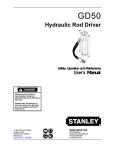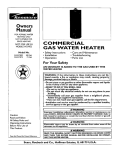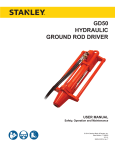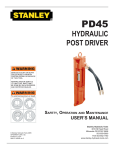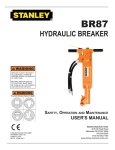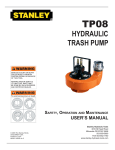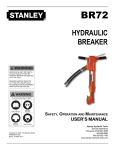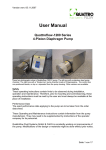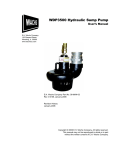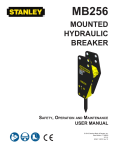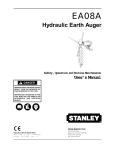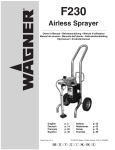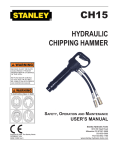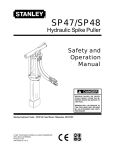Download GD50 Ops Man 5-05 Ver 4.indb
Transcript
GD50 HYDRAULIC ROD DRIVER WARNING SAFETY, OPERATION AND MAINTENANCE USER'S MANUAL © Stanley Hydraulic Tools 2005 OPS/MAINT USA / CE Printed in U.S.A. 39234 5/2005 ver 4 Stanley Hydraulic Tools 3810 SE Naef Road Milwaukie OR 97267-5698 503-659-5660 FAX 503-652-1780 www.stanley-hydraulic-tools.com TABLE OF CONTENTS SAFETY SYMBOLS......................................................................................................................................................................... 4 SAFETY PRECAUTIONS ................................................................................................................................................................ 5 TOOL STICKERS & TAGS .............................................................................................................................................................. 6 HYDRAULIC HOSE REQUIREMENTS ........................................................................................................................................... 7 HOSE TYPES .................................................................................................................................................................................. 7 HOSE SAFETY TAGS ..................................................................................................................................................................... 7 HTMA REQUIREMENTS ................................................................................................................................................................. 8 OPERATION .................................................................................................................................................................................... 9 PREOPERATION PROCEDURES .................................................................................................................................................. 9 PREPARATION FOR INITIAL USE.................................................................................................................................................. 9 CHECK TOOL .................................................................................................................................................................................. 9 CHECK TRIGGER MECHANISM .................................................................................................................................................... 9 CONNECT HOSES.......................................................................................................................................................................... 9 OPERATING PROCEDURES.......................................................................................................................................................... 9 INLINE CONTROL VALVEOPERATION .......................................................................................................................................... 9 SETTING FOR OPEN CENTER (O.C.) OR CLOSED CENTER (C.C.) .......................................................................................... 9 INSTALLING THE VALVE .............................................................................................................................................................. 10 OPERATING THE VALVE .............................................................................................................................................................. 10 COLD WEATHER OPERATION .................................................................................................................................................... 10 CHARGING THE ACCUMULATOR ................................................................................................................................................11 TESTING THE ACCUMULATOR PRESSURE ..............................................................................................................................11 EQUIPMENT PROTECTION & CARE........................................................................................................................................... 12 TROUBLESHOOTING ................................................................................................................................................................... 13 SPECIFICATIONS ......................................................................................................................................................................... 14 SPECIAL TOOLS ........................................................................................................................................................................... 14 PARTS ILLUSTRATION ................................................................................................................................................................. 15 PARTS LIST ................................................................................................................................................................................... 16 WARRANTY................................................................................................................................................................................... 17 SERVICING THE STANLEY HYDRAULIC Rod Driver. This manual contains safety, operation, and routine maintenance instructions. Stanley Hydraulic Tools recommends that servicing of hydraulic tools, other than routine maintenance, must be performed by an authorized and certified dealer. Please read the following warning. WARNING SERIOUS INJURY OR DEATH COULD RESULT FROM THE IMPROPER REPAIR OR SERVICE OF THIS TOOL. REPAIRS AND / OR SERVICE TO THIS TOOL MUST ONLY BE DONE BY AN AUTHORIZED AND CERTIFIED DEALER. For the nearest authorized and certified dealer, call Stanley Hydraulic Tools at the number listed on the back of this manual and ask for a Customer Service Representative. 3 SAFETY SYMBOLS Safety symbols and signal words, as shown below, are used to emphasize all operator, maintenance and repair actions which, if not strictly followed, could result in a life-threatening situation, bodily injury or damage to equipment. This is the safety alert symbol. It is used to alert you to potential personal injury hazards. Obey all safety messages that follow this symbol to avoid possible injury or death. DANGER This safety alert and signal word indicate an imminently hazardous situation which, if not avoided, will result in death or serious injury. WARNING This safety alert and signal word indicate a potentially hazardous situation which, if not avoided, could result in death or serious injury. CAUTION This safety alert and signal word indicate a potentially hazardous situation which, if not avoided, may result in minor or moderate injury. This signal word indicates a potentially hazardous situation which, if not avoided, may result in property damage. NOTICE This signal word indicates a situation which, if not avoided, will result in damage to the equipment. IMPORTANT This signal word indicates a situation which, if not avoided, may result in damage to the equipment. Always observe safety symbols. They are included for your safety and for the protection of the tool. LOCAL SAFETY REGULATIONS Enter any local safety regulations here. Keep these instructions in an area accessible to the operator and maintenance personnel. 4 SAFETY PRECAUTIONS Tool operators and maintenance personnel must always comply with the safety precautions given in this manual and on the stickers and tags attached to the tool and hose. These safety precautions are given for your safety. Review them carefully before operating the tool and before performing general maintenance or repairs. Supervising personnel should develop additional precautions relating to the specific work area and local safety regulations. If so, place the added precautions in the space provided in this manual. The GD50 Hydraulic Rod Driver will provide safe and dependable service if operated in accordance with the instructions given in this manual. Read and understand this manual and any stickers and tags attached to the tool and hoses before operation. Failure to do so could result in personal injury or equipment damage. • Operator must start in a work area without bystanders. The operator must be familiar with all prohibited work areas such as excessive slopes and dangerous terrain conditions. • Establish a training program for all operators to ensure safe operation. • Do not operate the tool unless thoroughly trained or under the supervision of an instructor. • Always wear safety equipment such as goggles, ear and head protection, and safety shoes at all times when operating the tool. • Do not inspect or clean the tool while the hydraulic power source is connected. Accidental engage ment of the tool can cause serious injury. • Always connect hoses to the tool hose couplers before energizing the hydraulic power source. Be sure all hose connections are tight. • Do not operate the tool at oil temperatures above 140°F/60°C. Operation at higher temperatures can cause higher than normal temperatures at the tool which can result in operator discomfort. • Do not operate a damaged, improperly adjusted, or incompletely assembled rod driver. • Do not weld, cut with an acetylene torch, or hardface the rod driver anvil or guide housing. • To avoid personal injury or equipment damage, all tool repair, maintenance and service must only be performed by authorized and properly trained personnel. • Always replace parts with replacement parts recommended by Stanley Hydraulic Tools. • Check fastener tightness often and before each use daily. 5 TOOL STICKERS & TAGS Model Number Location GD50 ROD DRIVER Stanley Hydraulic Tools 37425 Name Tag D A N G E R D A N G E R 1. FAILURE TO USE HYDRAULIC HOSE LABELED AND CERTIFIED AS NON-CONDUCTIVE WHEN USING HYDRAULIC TOOLS ON OR NEAR ELECTRICAL LINES MAY RESULT IN DEATH OR SERIOUS INJURY. BEFORE USING HOSE LABELED AND CERTIFIED AS NON-CONDUCTIVE ON OR NEAR ELECTRIC LINES BE SURE THE HOSE IS MAINTAINED AS NON-CONDUCTIVE. THE HOSE SHOULD BE REGULARLY TESTED FOR ELECTRIC CURRENT LEAKAGE IN ACCORDANCE WITH YOUR SAFETY DEPARTMENT INSTRUCTIONS. 2. The safety tag (p/n 15875) at right is attached to the tool when shipped from the factory. Read and understand the safety instructions listed on this tag before removal. We suggest you retain this tag and attach it to the tool when not in use. A HYDRAULIC LEAK OR BURST MAY CAUSE OIL INJECTION INTO THE BODY OR CAUSE OTHER SEVERE PERSONAL INJURY. A DO NOT EXCEED SPECIFIED FLOW AND PRESSURE FOR D DO NOT LIFT OR CARRY TOOL BY THE HOSES. DO NOT ABUSE HOSE. DO NOT USE KINKED, TORN OR DAMAGED HOSE. 3. MAKE SURE HYDRAULIC HOSES ARE PROPERLY CONNECTED TO THE TOOL BEFORE PRESSURING SYSTEM. SYSTEM PRESSURE HOSE MUST ALWAYS BE CONNECTED TO TOOL “IN” PORT. SYSTEM RETURN HOSE MUST ALWAYS BE CONNECTED TO TOOL “OUT” PORT. REVERSING CONNECTIONS MAY CAUSE REVERSE TOOL OPERATION WHICH CAN RESULT IN SEVERE PERSONAL INJURY. 4. DO NOT CONNECT OPEN-CENTER TOOLS TO CLOSED-CENTER HYDRAULIC SYSTEMS. THIS MAY RESULT IN LOSS OF OTHER HYDRAULIC FUNCTIONS POWERED BY THE SAME SYSTEM AND/OR SEVERE PERSONAL INJURY. 5. BYSTANDERS MAY BE INJURED IN YOUR WORK AREA. KEEP BYSTANDERS CLEAR OF YOUR WORK AREA. IMPORTANT IMPORTANT READ OPERATION MANUAL AND SAFETY INSTRUCTIONS FOR THIS TOOL BEFORE USING IT. READ OPERATION MANUAL AND SAFETY INSTRUCTIONS FOR THIS TOOL BEFORE USING IT. USE ONLY PARTS AND REPAIR PROCEDURES APPROVED BY STANLEY AND DESCRIBED IN THE OPERATION MANUAL. USE ONLY PARTS AND REPAIR PROCEDURES APPROVED BY STANLEY AND DESCRIBED IN THE OPERATION MANUAL. TAG TO BE REMOVED ONLY BY TOOL OPERATOR. TAG TO BE REMOVED ONLY BY TOOL OPERATOR. SAFETY TAG P/N 15875 6 Division of The Stanley Works 3810 SE Naef Road Milwaukie, Oregon 97267 USA FLOW: 26-34 LPM/7-9 GPM PRESS: 105-140 BAR 1500-2000 PSI ACCUMULATOR CHG: 42 BAR/600 PSI NITROGEN (shown smaller then actual size) HYDRAULIC HOSE REQUIREMENTS HOSE TYPES Hydraulic hose types authorized for use with Stanley Hydraulic Tools are as follows: Certified non-conductive Wire-braided (conductive) Fabric-braided (not certified or labeled non-conductive) Hose listed above is the only hose authorized for use near electrical conductors. Hoses and listed above are conductive and must never be used near electrical conductors. HOSE SAFETY TAGS To help ensure your safety, the following DANGER tags are attached to all hose purchased from Stanley Hydraulic Tools. DO NOT REMOVE THESE TAGS. If the information on a tag is illegible because of wear or damage, replace the tag immediately. A new tag may be obtained from your Stanley Distributor. D A N G E R D A N G E R 1 FAILURE TO USE HYDRAULIC HOSE LABELED AND CERTIFIED AS NON-CONDUCTIVE WHEN USING HYDRAULIC TOOLS ON OR NEAR ELECTRIC LINES MAYRESULT IN DEATH OR SERIOUS INJURY. FOR PROPER AND SAFE OPERATION MAKE SURE THAT YOU HAVE BEEN PROPERLY TRAINED IN CORRECT PROCEDURES REQUIRED FOR WORK ON OR AROUND ELECTRIC LINES. 3. DO NOT EXCEED HOSE WORKING PRESSURE OR ABUSE HOSE. IMPROPER USE OR HANDLING OF HOSE COULD RESULT IN BURST OR OTHER HOSE FAILURE. KEEP HOSE AS FAR AWAY AS POSSIBLE FROM BODY AND DO NOT PERMIT DIRECT CONTACT DURING USE. CONTACT AT THE BURST CAN CAUSE BODILY INJECTION AND SEVERE PERSONAL INJURY. 4. HANDLE AND ROUTE HOSE CAREFULLY TO AVOID KINKING, ABRASION, CUTTING, OR CONTACT WITH HIGH TEMPERATURE SURFACES. DO NOT USE IF KINKED. DO NOT USE HOSE TO PULL OR LIFT TOOLS, POWER UNITS, ETC. 2. BEFORE USING HYDRAULIC HOSE LABELED AND CERTIFIED AS NON-CONDUCTIVE ON OR NEAR ELECTRIC LINES. WIPE THE ENTIRE LENGTH OF THE HOSE AND FITTING WITH A CLEAN DRY ABSORBENT CLOTH TO REMOVE DIRT AND MOSISTURE AND TEST HOSE FOR MAXIMUM ALLOWABLE CURRENT LEAKAGE IN ACCORDANCE WITH SAFETY DEPARTMENT INSTRUCTIONS. 5. CHECK ENTIRE HOSE FOR CUTS CRACKS LEAKS ABRASIONS, BULGES, OR DAMAGE TO COUPLINGS IF ANY OF THESE CONDITIONS EXIST, REPLACE THE HOSE IMMEDIATELY. NEVER USE TAPE OR ANY DEVICE TO ATTEMPT TO MEND THE HOSE. 6. AFTER EACH USE STORE IN A CLEAN DRY AREA. SIDE 1 3 DO NOT REMOVE THIS TAG DO NOT REMOVE THIS TAG THE TAG SHOWN BELOW IS ATTACHED TO “CERTIFIED NON-CONDUCTIVE” HOSE SIDE 2 (shown smaller than actual size) D A N G E R D A N G E R 1 DO NOT USE THIS HYDRAULIC HOSE ON OR NEAR ELECTRIC LINES. THIS HOSE IS NOT LABELED OR CERTIFIED AS NON-CONDUCTIVE. USING THIS HOSE ON OR NEAR ELECTRICAL LINES MAY RESULT IN DEATH OR SERIOUS INJURY. 5. CHECK ENTIRE HOSE FOR CUTS CRACKS LEAKS ABRASIONS, BULGES, OR DAMAGE TO COUPLINGS IF ANY OF THESE CONDITIONS EXIST, REPLACE THE HOSE IMMEDIATELY. NEVER USE TAPE OR ANY DEVICE TO ATTEMPT TO MEND THE HOSE. 2. FOR PROPER AND SAFE OPERATION MAKE SURE THAT YOU HAVE BEEN PROPERLY TRAINED IN CORRECT PROCEDURES REQUIRED FOR WORK ON OR AROUND ELECTRIC LINES. 6. AFTER EACH USE STORE IN A CLEAN DRY AREA. 3. DO NOT EXCEED HOSE WORKING PRESSURE OR ABUSE HOSE. IMPROPER USE OR HANDLING OF HOSE COULD RESULT IN BURST OR OTHER HOSE FAILURE. KEEP HOSE AS FAR AWAY AS POSSIBLE FROM BODY AND DO NOT PERMIT DIRECT CONTACT DURING USE. CONTACT AT THE BURST CAN CAUSE BODILY INJECTION AND SEVERE PERSONAL INJURY. 4. HANDLE AND ROUTE HOSE CAREFULLY TO AVOID KINKING, CUTTING, OR CONTACT WITH HIGH TEMPERATURE SURFACES. DO NOT USE IF KINKED. DO NOT USE HOSE TO PULL OR LIFT TOOLS, POWER UNITS, ETC. DO NOT REMOVE THIS TAG DO NOT REMOVE THIS TAG THE TAG SHOWN BELOW IS ATTACHED TO “CONDUCTIVE” HOSE. SEE OTHER SIDE SIDE 1 SIDE 2 (shown smaller than actual size) HOSE PRESSURE RATING The rated working pressure of the hydraulic hose must be equal to or higher than the relief valve setting on the hydraulic system. 7 HTMA REQUIREMENTS TOOL CATEGORY HYDRAULIC SYSTEM REQUIREMENTS FLOW RATE TYPE 1 TYPE II 7-9 gpm (26-34 lpm) 2000 psi (138 bar) TYPE III TOOL OPERATING PRESSURE (at the power supply outlet) 4-6 gpm (15-23 lpm) 2000 psi (138 bar) SYSTEM RELIEF VALVE SETTING (at the power supply outlet) 2100-2250 psi 2100-2250 psi 2100-2250 psi 2200-2300 psi (145-155 bar) (145-155 bar) (145-155 bar) (152-159 bar) MAXIMUM BACK PRESSURE (at tool end of the return hose) 250 psi (17 bar) Measured at a max. fluid viscosity of: (at min. operating temperature) 400 ssu* 400 ssu* 400 ssu* 400 ssu* (82 centistokes) (82 centistokes) (82 centistokes) (82 centistokes) TEMPERATURE Sufficient heat rejection capacity to limit max. fluid temperature to: (at max. expected ambient temperature) 140° F (60° C) 140° F (60° C) 140° F (60° C) 140° F (60° C) Min. cooling capacity at a temperature difference of between ambient and fluid temps 3 hp (2.24 kW) 40° F (22° C) 5 hp (3.73 kW) 40° F (22° C) 7 hp (4.47 kW) 40° F (22° C) 6 hp (5.22 kW) 40° F (22° C) 250 psi (17 bar) 11-13 gpm (42-49 lpm) 2000 psi (138 bar) TYPE RR 250 psi (17 bar) 9-10.5 gpm (34-40 lpm) 2000 psi (138 bar) 250 psi (17 bar) NOTE: Do not operate the tool at oil temperatures above 140° F (60° C). Operation at higher temperatures can cause operator discomfort at the tool. FILTER 25 microns Min. full-flow filtration 30 gpm Sized for flow of at least: (114 lpm) (For cold temp. startup and max. dirt-holding capacity) 25 microns 30 gpm (114 lpm) HYDRAULIC FLUID Petroleum based (premium grade, anti-wear, non-conductive) VISCOSITY (at min. and max. operating temps) 100-400 ssu* 100-400 ssu* (20-82 centistokes) 100-400 ssu* 25 microns 30 gpm (114 lpm) 25 microns 30 gpm (114 lpm) 100-400 ssu* NOTE: When choosing hydraulic fluid, the expected oil temperature extremes that will be experienced in service determine the most suitable temperature viscosity characteristics. Hydraulic fluids with a viscosity index over 140 will meet the requirements over a wide range of operating temperatures. *SSU = Saybolt Seconds Universal NOTE: These are general hydraulic system requirements. See tool Specification page for tool specific requirements. 8 OPERATION 3. Observe flow indicators stamped on hose couplers to be sure that oil will flow in the proper direction. The female coupler is the inlet coupler. PREOPERATION PROCEDURES PREPARATION FOR INITIAL USE Note: The pressure increase in uncoupled hoses left in the sun may result in making them difficult to connect. When possible, connect the free ends of operating hoses together. Each unit as shipped has no special unpacking or assembly requirements prior to usage. Inspection to assure the unit was not damaged in shipping and does not contain packing debris is all that is required. Check Hydraulic Power Source OPERATING PROCEDURES 1. Using a calibrated flowmeter and pressure gauge, check that the hydraulic power source develops a flow of 7-9 gpm/26-34 lpm for HTMA type II tools/EHTMA category D at 2000 psi/105-140 bar. 1. Observe all safety precautions. 2. Make certain the hydraulic power source is equipped with a relief valve set to open at 2100-2250 psi/145-155 bar minimum. 3. Place the anvil of the rod driver over the rod to be driven. 2. Move the hydraulic circuit control valve to the "ON" position. 4. Ensure adequate down pressure is applied to the rod driver before starting the rod driver. To start the rod driver, press the button on the control valve to the "ON" position. Adequate down pressure is very important. When you wish to stop the tool, press the button on the control valve to the "OFF" position. 3. Check that the hydraulic circuit matches the tool for open-center (OC) operation. CHECK TOOL 1. Make sure the tool contains the correct anvil for the rod size to be driven. Use the 5/8 inch anvil (standard in the model GD50132RF Rod Driver) for 5/8 inch diameter rod. Use the 1 inch anvil (standard in the model GD50133RF Rod Driver) for 3/4 inch to 1 inch diameter rod. Failure to use the correct anvil with the appropriate rod size can result in damage to the tool or personal injury. INLINE CONTROL VALVE OPERATION The 38632 Inline Control Valve is designed to provide the ON/OFF functions for a hydraulic tool connected to either an OPEN CENTER (O.C.) hydraulic system or an CLOSED CENTER (C.C.) hydraulic system. The valve is to be used with tools which do not have an ON/OFF trigger control. The 38632 Control Valve can be used on hydraulic systems producing up to 10 gpm/38 lpm with a maximum relief valve setting of 2500 psi/172 bar. The valve ports are -8 SAE (3/4-16 thread) o-ring ports. 2. There should be no signs of leaks. 3. The tool should be clean, with all fittings and fasteners tight. SETTING FOR OPEN CENTER (O.C.) OR CLOSED CENTER (C.C.) CHECK TRIGGER MECHANISM Set the valve to O.C. or C.C. before connecting it to the hydraulic system. To set the valve for open center operation, use a straight blade screw driver to turn the selector screw counter clockwise until it stops. To set the valve for closed center operation, turn the selector screw clockwise until it stops. 1. Check that the trigger operates smoothly and is free to travel between the "ON" and "OFF" positions. CONNECT HOSES CAUTION 1. Wipe all hose couplers with a clean lint-free cloth before making connections. Be sure you know if you have an OPEN CENTER (O.C.) OR CLOSED CENTER (C.C.) hydraulic system, DO NOT attempt to install or operate the 38632 Valve until you do. Incorrect installation or operation of the valve can result in seal failures in the tool, cause excessive heat in the hydraulic system, and may damage the tool and hydraulic system. Understand which type of hydraulic system you are using before installing or operating this valve. 2. Connect the hoses from the hydraulic power source to the hose couplers on the rod driver. It is a good practice to connect the return hose first and disconnect it last to minimize or avoid trapped pressure within the rod driver. 9 OPERATION INSTALLING THE VALVE COLD WEATHER OPERATION Connect the valve to the hydraulic system as shown in the illustration. If the rod driver is to be used during cold weather, preheat the hydraulic fluid at low engine speed. When using the normally recommended fluids, fluid temperature should be at or above 50° F/10° C (400 ssu/82 centistokes) before use. OPERATING THE VALVE Connect the valve to the tool using the illustration below as a guide. Make sure the valve spool on the valve is pushed OFF before connecting the valve to the hydraulic system. Make sure the hydraulic system is OFF before connecting the valve to the hydraulic system. Connect the valve to the hydraulic system. Turn ON the hydraulic system. Place the tool to be operated in its operating position. Push the valve spool ON to begin operating the tool. Push the valve spool OFF to stop operating the tool. Turn the hydraulic system OFF before disconnecting the valve. Selector Screw Tool Hoses IN 38632 Valve (PRESSURE) 00936 Adapter Fittings Quick Disconnect Couplers OUT (RETURN) 10 CHARGING THE ACCUMULATOR Note: It may be necessary to set the regulator at 650-700 psi/41-48 bar to overcome any pressure drop through the charging system. To check or charge the accumulator the following equipment is required: • Charge kit (Part Number 31254) Includes the following: 6. Open the valve on the charging assembly hose. When the tester gauge reads 600-700 psi41-48 bar, close the valve on the charging assembly hose and remove the charging assembly. • Accumulator tester (Part Number 02835). • Charge assembly (Part Number 15304). Includes a liquid-filled gauge with snub valve, hose and fittings. • NITROGEN bottle with a 800 psi/56 bar minimum charge (not a part of 31254 kit). 7. Turn the gauge end of the tester fully counterclockwise to retract the plunger in the chuck. Remove the tester from the charge valve. 1. Holding the chuck end of the Stanley tester (p/n 02835), turn the gauge fully counterclockwise to ensure the stem inside the chuck is completely retracted. 8. Replace the valve cap. TESTING THE ACCUMULATOR PRESSURE 2. Thread the tester onto the charging valve of the tool accumulator (do not advance the gauge-end into the chuck end. Turn as a unit). Seat the chuck on the accumulator charging valve by hand tightening only. 1. Follow instructions 1 through 3 under "CHARGING THE ACCUMULATOR". 3. Advance the valve stem by turning the gauge- end clockwise. 2. Read the pressure on the gauge. It should be between 500-700 psi/35-48 bar. 4. Connect the charging assembly to the valve on the tester. 3. If the pressure is low, recharge the tool. 5. Adjust the regulator on the nitrogen bottle to 600 psi/42 bar. Liquid Filled Gauge w/Snub Valve Charge Fitting Nitrogen Tank (Not included in Kit) Charging Valve 31254 ACCUMULATOR CHARGE KIT Includes: Liquid Filled Gauge w/Snub Valve, Hose, Charge Fitting, 02835 Tester, and Box (not pictured) Hose Gauge 02835 TESTER Chuck 11 EQUIPMENT PROTECTION & CARE NOTICE In addition to the Safety Precautions in this manual, observe the following for equipment protection and care. • Make sure all couplers are wiped clean before connection. • The hydraulic circuit control valve must be in the “OFF” position when coupling or uncoupling hydraulic tools. Failure to do so may result in damage to the quick couples and cause overheating of the hydraulic system. • Always store the tool in a clean dry space, safe from damage or pilferage. • Make sure the circuit PRESSURE hose (with male quick disconnect) is connected to the “IN” port. The circuit RETURN hose (with female quick disconnect) is connected to the opposite port. Do not reverse circuit flow. This can cause damage to internal seals. • Always replace hoses, couplings and other parts with replacement parts recommended by Stanley Hydraulic Tools. Supply hoses must have a minimum working pressure rating of 2500 psi/172 bar. • Do not exceed the rated flow (see Specifications) in this manual for correct flow rate and model number. Rapid failure of the internal seals may result. • Always keep critical tool markings, such as warning stickers and tags legible. • Tool repair should be performed by experienced personnel only. • Make certain that the recommended relief valves are installed in the pressure side of the system. • Do not use the tool for applications for which it was not intended. 12 TROUBLESHOOTING If symptoms of poor performance develop, the following chart can be used as a guide to correct the problem. When diagnosing faults in operation of the spike driver, always check that the hydraulic power source is supplying the correct hydraulic flow and pressure to the spike driver as listed in the table. Use a flowmeter known to be accurate. Check the flow with the hydraulic oil temperature at least 80°F/27°C. PROBLEM Rod driver does not run. Rod driver does not hit effectively. Rod driver operates slow. CAUSE SOLUTION Power unit not functioning. Check power unit for proper flow and pressure (7-9 gpm / 26-34 lpm at 2000 psi / 140 bar). Couplers or hoses blocked. Remove restriction. Pressure and return line hoses reversed at ports. Be sure hoses are connected to their proper ports. Mechanical failure of piston or automatic valve. Have inspected and repaired by an authorized dealer. Power unit not functioning. Check power unit for proper flow and pressure (7-9 gpm / 26-34 lpm at 2000 psi / 140 bar). Couplers or hoses blocked. Remove restriction. Low accumulator charge (pressure hose will pulse more than normal). Have recharged by an authorized dealer. Fluid too hot. (above 140º F / 60º C) Provide cooler to maintain proper fluid temperature. Rod anvil is not sliding freely in the anvil guide. Remove, clean and replace as necessary. Low oil flow from power unit. Check power source for proper flow. High back-pressure. Check hydraulic system for excessive back-pressure and correct as required. 13 SPECIFICATIONS Capacity (Rod Anvil) 1/2 to 5/8 inch/12 to 16 mm diameter rod (model GD50132RF) 3/4 to 1 inch/19 to 25 mm diameter rod (model GD50133RF) Pressure Range .........................................................................................................................1500-2000 psi/105-140 bar Maximum Back Pressure ............................................................................................................................... 250 psi/17 bar Flow Range ............................................................................................................................................ 7-9 gpm/26-34 lpm Couplers ...................................................................................................HTMA/EHTMA Flush Face Type Male & Female Hose Whips ..................................................................................................................................................................... Yes Weight ................................................................................................................................................57.3 lbs./26 kg Overall Length .......................................................................................................................................25.5 inches/64.8 cm Overall Width ............................................................................................................................................10 inches/25.4 cm Maximum Fluid Temperature ............................................................................................................................ 140° F/60° C SPECIAL TOOLS DESCRIPTION O-ring Tool Kit Split Rings Flow Sleeve Removal Tool Flow Sleeve Removal Tube Bearing Puller Kit Accumulator Disassembly Tool Tamper Sleeve Tool Accumulator Cylinder Puller PART NUMBER 04337 04908 04919 04910 05064 05508 01120 05640 USAGE General Service of Seals Used with 04910 Flow Sleeve Removal Used with 04908 & 05508 General Bearing Pulling Used with 04910 Used to Pull Porting Block from Valve Block An Aluminum Disk (handy for protecting parts when using an arbor press 14 PARTS ILLUSTRATION 41 6 5 40 3 7 39 8 38 37 9 2 52 10 2 11 1 12 42 36 SERIAL NO. 43 13 44 35 45 14 15 18 46 17 17 18 32 34 19 20 33 21 51 32 31 23 24 Serial Number 430 and Above 47 25 48 16 30 49 8 25 29 24 50 26 22 23 IN 27 28 15 PARTS LIST Item Part No. Qty. Description Item Part No. Qty. Description 1 35770 2 Handle Bar 37 04954 1 Piston 2 70351 4 Capscrew 38 02022 1 O-ring 3 07493 1 O-Ring Plug-Male 39 04387 1 Wiper Ring 4 05243 1 Orifice Plug (Included with Item 13) 40 04780 1 Back-up Washer 5 20499 1 Charge Valve 41 04386 1 Cup Seal 6 04374 4 Lock Nut 42 12139 4 Side Rod 7 15190 1 Top Plate 43 43527 1 Adaptor Block 8 00720 4 Set Screw 44 12143 1 Upper Anvil Stop 9 07479 1 Diapragm 45 12146 1 Spring 10 00293 1 O-ring 46 36106 1 11 15188 1 Valve Spool Rod Anvil, 5/8 inch rods (Model GD50132) 12 04058 1 Spring 35751 1 Rod Anvil, 3/4 to 1 in. Rods (Model GD50133) 13 11588 1 Accumulator Valve Block 47 14 01605 2 O-ring (Included with Item 15) 35752 65812 1 1 Anvil Guide (Serial No. 429 & Below) Anvil Guide (Serial No. 430 & Above) 48 35753 1 Guide Housing 15 350000 2 Elbow, 45° (Included with item 14) 49 38629 1 Valve Body Assy. 16 10536 1 Selector Screw 17 04381 2 Back-up Ring 50 00026 1 O-ring 18 04379 2 O-ring 51 65813 1 Bumper (Used on Serial No. 430 & Above) 19 04378 1 Porting Block 52 371071 2 Washer 20 35784 2 Hose Assy 21 07480 1 Automatic Valve Body 22 16070 1 Retaining Ring 23 01003 2 Valve Button 24 13568 2 Back-up Ring 25 13567 2 O-ring 26 38631 1 Valve Spool 27 00936 2 Adaptor 28 24059 1 Male Coupler Body 29 24058 1 Female Coupler Body 30 04382 1 Automatic Valve 31 04571 2 Push Pin 32 02900 2 Roll Pin 33 37425 1 Name Tag 34 04383 1 Flow Sleeve Tube 35 04384 1 Flow Sleeve 36 04605 4 Push Pin Model GD50132RF - 1/2 and 5/8 inch rods. Model GD50133RF - 3/4 and 1 inch rods. Verify the correct model number before ordering. Seal Kit GD50 Rapid Fire Model - 04595 All Other Models - 13552 16 WARRANTY Stanley Hydraulic Tools (hereinafter called “Stanley”), subject to the exceptions contained below, warrants new hydraulic tools for a period of one year from the date of sale to the first retail purchaser, or for a period of 2 years from the shipping date from Stanley, whichever period expires first, to be free of defects in material and/or workmanship at the time of delivery, and will, at its option, repair or replace any tool or part of a tool, or new part, which is found upon examination by a Stanley authorized service outlet or by Stanley’s factory in Milwaukie, Oregon to be DEFECTIVE IN MATERIAL AND/OR WORKMANSHIP. EXCEPTIONS FROM WARRANTY NEW PARTS: New parts which are obtained individually are warranted, subject to the exceptions herein, to be free of defects in material and/or workmanship at the time of delivery and for a period of 6 months after the date of first usage. Seals and diaphragms are warranted to be free of defects in material and/or workmanship at the time of delivery and for a period of 6 months after the date of first usage or 2 years after the date of delivery, whichever period expires first. Warranty for new parts is limited to replacement of defective parts only. Labor is not covered. FREIGHT COSTS: Freight costs to return parts to Stanley, if requested by Stanley for the purpose of evaluating a warranty claim for warranty credit, are covered under this policy if the claimed part or parts are approved for warranty credit. Freight costs for any part or parts which are not approved for warranty credit will be the responsibility of the individual. SEALS & DIAPHRAGMS: Seals and diaphragms installed in new tools are warranted to be free of defects in material and/or workmanship for a period of 6 months after the date of first usage, or for a period of 2 years from the shipping date from Stanley, whichever period expires first. CUTTING ACCESSORIES: Cutting accessories such as breaker tool bits are warranted to be free of defects in material and or workmanship at the time of delivery only. ITEMS PRODUCED BY OTHER MANUFACTURERS: Components which are not manufactured by Stanley and are warranted by their respective manufacturers. a. Costs incurred to remove a Stanley manufactured component in order to service an item manufactured by other manufacturers. ALTERATIONS & MODIFICATIONS: Alterations or modifications to any tool or part. All obligations under this warranty shall be terminated if the new tool or part is altered or modified in any way. NORMAL WEAR: any failure or performance deficiency attributable to normal wear and tear such as tool bushings, retaining pins, wear plates, bumpers, retaining rings and plugs, rubber bushings, recoil springs, etc. INCIDENTAL/CONSEQUENTIAL DAMAGES: To the fullest extent permitted by applicable law, in no event will STANLEY be liable for any incidental, consequential or special damages and/or expenses. FREIGHT DAMAGE: Damage caused by improper storage or freight handling. LOSS TIME: Loss of operating time to the user while the tool(s) is out of service. IMPROPER OPERATION: Any failure or performance deficiency attributable to a failure to follow the guidelines and/or procedures as outlined in the tool’s operation and maintenance manual. MAINTENANCE: Any failure or performance deficiency attributable to not maintaining the tool(s) in good operating condition as outlined in the Operation and Maintenance Manual. HYDRAULIC PRESSURE & FLOW, HEAT, TYPE OF FLUID: Any failure or performance deficiency attributable to excess hydraulic pressure, excess hydraulic back-pressure, excess hydraulic flow, excessive heat, or incorrect hydraulic fluid. REPAIRS OR ALTERATIONS: Any failure or performance deficiency attributable to repairs by anyone which in Stanley’s sole judgement caused or contributed to the failure or deficiency. MIS-APPLICATION: Any failure or performance deficiency attributable to mis-application. “Mis-application” is defined as usage of products for which they were not originally intended or usage of products in such a matter which exposes them to abuse or accident, without first obtaining the written consent of Stanley. PERMISSION TO APPLY ANY PRODUCT FOR WHICH IT WAS NOT ORIGINALLY INTENDED CAN ONLY BE OBTAINED FROM STANLEY ENGINEERING. WARRANTY REGISTRATION: STANLEY ASSUMES NO LIABILITY FOR WARRANTY CLAIMS SUBMITTED FOR WHICH NO TOOL REGISTRATION IS ON RECORD. In the event a warranty claim is submitted and no tool registration is on record, no warranty credit will be issued without first receiving documentation which proves the sale of the tool or the tools’ first date of usage. The term “DOCUMENTATION” as used in this paragraph is defined as a bill of sale, or letter of intent from the first retail customer. A WARRANTY REGISTRATION FORM THAT IS NOT ALSO ON RECORD WITH STANLEY WILL NOT BE ACCEPTED AS “DOCUMENTATION”. NO ADDITIONAL WARRANTIES OR REPRESENTATIONS This limited warranty and the obligation of Stanley thereunder is in lieu of all other warranties, expressed or implied including merchantability or fitness for a particular purpose except for that provided herein. There is no other warranty. This warranty gives the purchaser specific legal rights and other rights may be available which might vary depending upon applicable law. 17 Stanley Hydraulic Tools 3810 SE Naef Road Milwaukie, Oregon 503-659-5660 / Fax 503-652-1780 www.stanley-hydraulic-tools.com


















